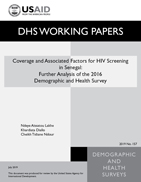
Abstract:
Introduction: The aim of this study was to
assess the factors associated with HIV
testing among in sexually active women and
men in Senegal. Knowledge of HIV status is
the gateway to antiretroviral treatment.
Despite the adoption of the provider-
initiated HIV testing strategy, the rate of
HIV testing is still very low in sub-Saharan
Africa.
Methods: A secondary analysis of the 2017
Senegal Demographic and Health Survey (DHS)
was performed using data on sexually active
women age 15-49 and men age 15-59. The
outcome variable was the proportion of women
and men who reported ever being tested for
HIV in the last 12 months before the survey.
Descriptive, bivariate, and multivariable
logistic regression analyses were performed
to identify the sociodemographic, HIV
knowledge, media exposure, and behavioral
factors associated with HIV testing in
Senegal.
Results: The study found that 62% of women
and 27% of men were tested for HIV in the
last 12 months before the survey. In
multivariate analysis, among men the factors
independently associated with being tested
for HIV were: older age group (50-54); a high
level of education; being in the richest
household wealth quintile; being married;
knowing about the efficacy of HART during
pregnancy; and owning a mobile phone. Among
women factors independently associated with
HIV testing were: older age group (30-34); a
high level of education; being in the richest
household wealth quintile; being married;
knowing about the efficacy of HART during
pregnancy; having any sexually transmitted
infection (STI) in last 12 months; fearing
stigma; owning a mobile phone; and having any
number of ANC visits, versus none. By region
of residence, compared with the West zone,
men in the North and South-East zones were
significantly less likely to have been tested
for HIV in the 12 months before the survey.
Similarly, women in the North, Center, and
South-East zones were less likely to be
tested for HIV compared with the West zone.
Conclusion: Although HIV remains a public
health threat, 73% of men and 38% women in
Senegal were not tested for HIV in the last
12 months. Low prevalence of HIV testing
makes it difficult to interrupt the
transmission chain within the community and
to reach the UNAIDS goal for 2020 of 90% of
HIV-positive people being aware of their
status, 90% of those receiving antiretroviral
therapy, and 90% of those virally suppressed.
Innovative community-based strategies are
needed to address barriers and improve access
to HIV testing, particularly for men and for
the youngest and poorest populations, and to
narrow the disparities in awareness of HIV
status in Senegal.
 Coverage and Associated Factors for HIV Screening in Senegal: Analysis of the 2017 Demographic and Health Survey (PDF, 521K)
Coverage and Associated Factors for HIV Screening in Senegal: Analysis of the 2017 Demographic and Health Survey (PDF, 521K)
